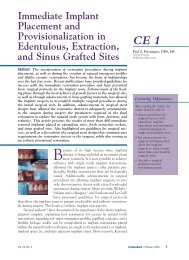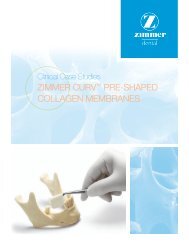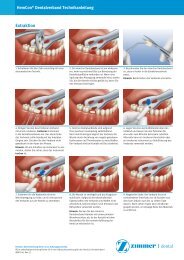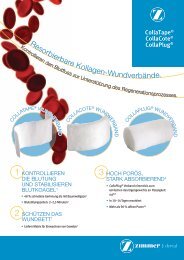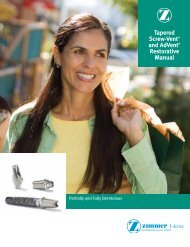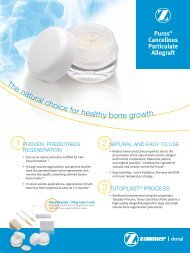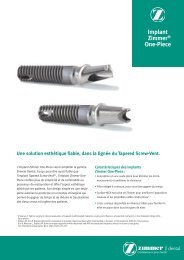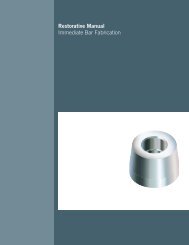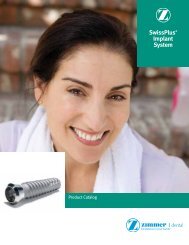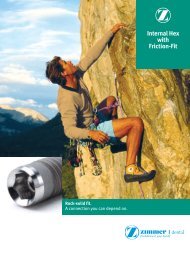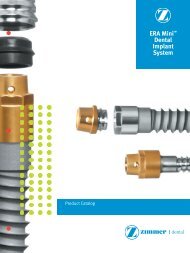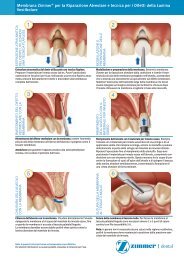Trabecular Metal Technology - Zimmer Dental
Trabecular Metal Technology - Zimmer Dental
Trabecular Metal Technology - Zimmer Dental
You also want an ePaper? Increase the reach of your titles
YUMPU automatically turns print PDFs into web optimized ePapers that Google loves.
<strong>Zimmer</strong> ®<br />
<strong>Trabecular</strong><br />
<strong>Metal</strong> <br />
<strong>Dental</strong><br />
Implant<br />
TRABECULAR METAL MATERIAL:<br />
Designed to Enhance Secondary Stability Through Bone Ingrowth.<br />
Artistic Rendering
osseoincorporation<br />
TRABECULAR METAL<br />
MATERIAL<br />
Designed to Enhance Secondary<br />
Stability Through Bone Ingrowth<br />
The <strong>Zimmer</strong> <strong>Trabecular</strong> <strong>Metal</strong> <strong>Dental</strong><br />
Implant combines the popular features<br />
of the Tapered Screw-Vent ® Implant<br />
with the unique properties of<br />
<strong>Trabecular</strong> <strong>Metal</strong> Material. Due to the<br />
interconnected porosity it is designed<br />
to enhance secondary stability through<br />
osseoincorporation.
Osseoincorporation<br />
Ongrowth + Ingrowth:<br />
<strong>Zimmer</strong> <strong>Dental</strong>’s MTX ® Microtextured Surface has been documented to achieve high levels of bone-toimplant<br />
contact, or ongrowth. 1,2 The <strong>Trabecular</strong> <strong>Metal</strong> <strong>Dental</strong> Implant features an osteoconductive mid-section<br />
designed for bone ingrowth as well as ongrowth in a process new to implant dentistry – osseoincorporation. 3-5<br />
Osseoincorporation refers to the healing potential of bone onto an implant surface and into an implant structure.<br />
The interconnected porosity of <strong>Trabecular</strong> <strong>Metal</strong> Material is designed to enhance secondary stability through<br />
a high volume of ingrowth. 5,9,21 Studies of the <strong>Trabecular</strong> <strong>Metal</strong> <strong>Dental</strong> Implant are currently underway and<br />
additional studies are planned to document the process of osseoincorporation by measuring the volume and<br />
rate of bone ingrowth.<br />
<strong>Trabecular</strong> <strong>Metal</strong> Material<br />
Osseoincorporation<br />
<strong>Trabecular</strong> bone<br />
The process of ingrowth<br />
Artistic Rendering<br />
The Best Thing Next to Bone <br />
<strong>Trabecular</strong> <strong>Metal</strong> <strong>Technology</strong> is a three-dimensional material,<br />
not an implant surface or coating. Its structure is similar to<br />
cancellous bone. 4,6,10 <strong>Trabecular</strong> <strong>Metal</strong> Material has up to<br />
80% fully interconnected porosity designed for bone<br />
ingrowth. 3-5,7,10,11<br />
<strong>Trabecular</strong> <strong>Metal</strong> Material at 200x<br />
<strong>Zimmer</strong> has utilized <strong>Trabecular</strong> <strong>Metal</strong> Material –<br />
The Best Thing Next to Bone – for over a decade in<br />
implantable orthopaedic devices. Now <strong>Zimmer</strong> brings<br />
this unique technology to implant dentistry with the<br />
<strong>Trabecular</strong> <strong>Metal</strong> <strong>Dental</strong> Implant.
The Evolution of a Trusted Design<br />
<strong>Zimmer</strong> <strong>Dental</strong> proudly introduces the <strong>Trabecular</strong> <strong>Metal</strong> <strong>Dental</strong> Implant, a premium<br />
addition to the Tapered Screw-Vent Implant System – the implant family trusted by clinicians<br />
for over a decade.<br />
Sharing some of the most popular Tapered Screw-Vent Implant design features, the new<br />
<strong>Trabecular</strong> <strong>Metal</strong> <strong>Dental</strong> Implant offers clinicians additional treatment planning options.<br />
Tapered Screw-Vent Implant<br />
<strong>Trabecular</strong> <strong>Metal</strong> Material<br />
<strong>Trabecular</strong> <strong>Metal</strong> Implant<br />
Compatibility for versatility<br />
The <strong>Trabecular</strong> <strong>Metal</strong> <strong>Dental</strong> Implant is placed with the <strong>Zimmer</strong><br />
Instrument Kit System and restored using the extensive selection of<br />
Tapered Screw-Vent prosthetic components. This compatibility allows for<br />
convenient integration of the <strong>Trabecular</strong> <strong>Metal</strong> <strong>Dental</strong> Implant into treatment plans<br />
without requiring additional surgical purchases or new restorative procedures.
<strong>Trabecular</strong> <strong>Metal</strong> Den<br />
The Best Thing Next to Bone. <br />
5<br />
Tapered Implant Body<br />
Designed for primary stability, the tapered<br />
titanium alloy body provides the strength of<br />
traditional dental implants. 15-18<br />
4<br />
MTX Surface for ongrowth<br />
The MTX Microtextured Surface has been documented<br />
to achieve high levels of bone-to-implant contact, or<br />
ongrowth. 1,2
tal Implant<br />
1<br />
<strong>Trabecular</strong> <strong>Metal</strong> MATERIAL for bone ingrowth<br />
The implant’s <strong>Trabecular</strong> <strong>Metal</strong> Material mid-section has been<br />
designed for bone ingrowth and ongrowth. 3-5 <strong>Zimmer</strong> <strong>Dental</strong><br />
continues to gather data to document the volume<br />
and rate of osseoincorporation and its effects on<br />
secondary stability.<br />
2<br />
crestal options for<br />
bone-level maintenance<br />
The coronal microgrooves are designed to<br />
preserve crestal bone. 14<br />
Two coronal surface configurations are available:<br />
• 0.5mm Machined Titanium<br />
(Model TMM, shown above).<br />
• MTX Microtexturing to the top<br />
(Model TMT, shown to the left).<br />
The Virtual Cold Weld<br />
Abutment<br />
Implant<br />
3<br />
Platform Plus <br />
<strong>Technology</strong><br />
The proprietary internal hex connection,<br />
utilized with <strong>Zimmer</strong> <strong>Dental</strong>’s friction-fit<br />
abutments, has been documented to<br />
shield crestal bone from concentrated<br />
occlusal forces, in an in vitro FEA. 12,13*<br />
*<br />
Results are not necessarily predictive<br />
of human clinical results.
Clinical Cases<br />
Human clinical studies of the <strong>Trabecular</strong> <strong>Metal</strong> <strong>Dental</strong> Implant began<br />
in 2010, and data collection will continue in the coming years.<br />
Additional studies to document osseoincorporation in<br />
humans and animals are in progress. In 2011, the<br />
availability of the <strong>Trabecular</strong> <strong>Metal</strong> <strong>Dental</strong> Implant<br />
was extended to clinicians and their patients in<br />
Europe, and in 2012, the United States and<br />
other countries.<br />
In a preliminary study of <strong>Trabecular</strong> <strong>Metal</strong><br />
<strong>Dental</strong> Implants in canine mandibular<br />
models, evidence of ingrowth by maturing<br />
bone was documented as early as two weeks<br />
after implantation. 19,20 Further data is being<br />
collected to document the rate of ingrowth and<br />
its effects on secondary stability in human<br />
dental applications.<br />
<strong>Trabecular</strong> <strong>Metal</strong> <strong>Dental</strong> Implant placed<br />
in the maxilla and immediately loaded.<br />
Image ©2012 Dr. Markus Schlee,<br />
Forchheim, Germany.<br />
Final restoration<br />
at 14 days*<br />
<strong>Trabecular</strong> <strong>Metal</strong> <strong>Dental</strong> Implant<br />
placed in the mandible.<br />
Images ©2012 Dr. Markus Schlee,<br />
Forchheim, Germany.<br />
One-year result<br />
*Immediate loading is indicated when there is good<br />
primary stability and an appropriate occlusal load.
References<br />
1. <br />
Trisi P, Marcato C, Todisco M. Bone-to-implant apposition<br />
with machined and MTX microtextured implant surfaces in<br />
human sinus grafts. Int J Periodontics Restorative Dent.<br />
2003;23(5):427-437.<br />
2.<br />
Todisco M, Trisi P. Histomorphometric evaluation of six<br />
dental implant surfaces after early loading in augmented<br />
human sinuses. J Oral Implantol. 2006;32(4):153-166.<br />
3.<br />
Wigfield C, Robertson J, Gill S, Nelson R. Clinical experience<br />
with porous tantalum cervical interbody implants in a prospective<br />
randomized controlled trial. Br J Neurosurg.<br />
2003;17(5):418-425.<br />
4.<br />
Unger AS, Lewis RJ, Gruen T. Evaluation of a porous<br />
tantalum uncemented acetabular cup in revision total<br />
hip arthroplasty. Clinical and radiological results of<br />
60 hips. J Arthroplasty. 2005;20(8):1002-1009.<br />
5.<br />
Bobyn JD, Stackpool GJ, Hacking SA, Tanzer M, Krygier JJ.<br />
Characteristics of bone ingrowth and interface mechanics<br />
of a new porous tantalum biomaterial.J Bone Joint Surg Br.<br />
1999; 81:907-914.<br />
6.<br />
Cohen R. A porous tantalum trabecular metal: basic<br />
science. Am J Orthop. 2002;31(4):216-217.<br />
7.<br />
Tsao AK, Roberson JR, Christie MJ, Dore DD, Heck DA,<br />
Robertson DD, Poggie RA. Biomechanical and clinical<br />
evaluations of a porous tantalum implant for the treatment<br />
of early-stage osteonecrosis. J Bone Joint Surg.<br />
2005;87-A(Suppl 2):22-27.<br />
8.<br />
Williams DF. Titanium as a metal for implantation. Part 1:<br />
Physical properties. J Med Eng Tech. 1977;7:195-198,202.<br />
For more information about the <strong>Zimmer</strong> <strong>Trabecular</strong> <strong>Metal</strong><br />
<strong>Dental</strong> Implant, visit trabecularmetal.zimmerdental.com.<br />
1900 Aston Avenue<br />
Carlsbad, CA 92008-7308<br />
USA<br />
In the U.S. 1 (800) 854-7019<br />
To fax an order 1 (888) 225-2483<br />
Outside the U.S. +1 (760) 929-4300<br />
Australia +61 (0)2 9950 5434 or 1 (800) 241 916<br />
Canada + 1 (905) 567-2073 or 1 (800) 265-0968<br />
Chile +562 231 5185<br />
9.<br />
Bobyn JD, Hacking SA, Chan SP, et al. Characterization of<br />
a new porous tantalum biomaterial for reconstructive<br />
orthopaedics. Scientific Exhibit, Proc of AAOS, Anaheim,<br />
CA, 1999.<br />
10.<br />
Bobyn JD. UHMWPE: the good, bad, & ugly. Fixation<br />
and bearing surfaces for the next millennium. Orthop.<br />
1999;22(9):810-812.<br />
11.<br />
Nasser S, Poggie RA. Revision and salvage patellar arthroplasty<br />
using a porous tantalum implant. J Arthroplasty.<br />
2004;19(5):562-572.<br />
12.<br />
Mihalko WM, May TC, Kay JF, Krause WP. Finite element<br />
analysis of interface geometry effects on the crestal<br />
bone surrounding a dental implant. Implant Dent.<br />
1992;1:212-217.<br />
13.<br />
Chun HJ, Shin HS, Han CH, Lee SH. Influence of implant<br />
abutment type on stress distribution in bone under<br />
various loading conditions using finite element analysis.<br />
Int J Oral Maxillofac Implants. 2006;21:105-202.<br />
14.<br />
Shin SY, Han DH. Influence of a microgrooved collar<br />
design on soft and hard tissue healing of immediate<br />
implantation in fresh extraction sites in dogs.<br />
Clin Oral Implants Res. 2010;21:804-814.<br />
15.<br />
Data on file., 16. Data on file., 17. Data on file.,<br />
18.<br />
Data on file., 19. Data on file., 20. Data on file.<br />
21.<br />
Data on file.<br />
China +86 21 22115147<br />
France +33 (0)1 45 12 35 35<br />
Germany +49 (0)761 1 56 47 0<br />
Israel +972 (0)3 6124242<br />
Italy +39 0438 37681<br />
Spain +34 93 846 05 43<br />
©2012 <strong>Zimmer</strong> <strong>Dental</strong> Inc. All rights reserved. 5986, Rev. 12/12.<br />
Please note that not all products are registered or available in every country/region.<br />
Please check with a <strong>Zimmer</strong> <strong>Dental</strong> representative for availability and additional information.<br />
To receive our eNews visit us at http://www.zimmerdental.com/news_eNewsLetterSignUp.aspx<br />
www.zimmerdental.com<br />
Information on the products and procedures contained in this document is of a<br />
general nature and does not represent and does not constitute medical advice or<br />
recommendations. Because this information does not purport to constitute any<br />
diagnostic or therapeutic statement with regard to any individual medical case, each<br />
patient must be examined and advised individually, and this document does not<br />
replace the need for such examination and/or advice in whole or in part. Please refer<br />
to the package inserts for important product information, including, but not limited to,<br />
contraindications, warnings, precautions, and adverse effects.



